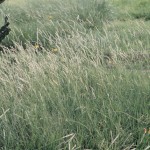Tobosagrass Ergot
Claviceps cinerea
Poaceae
Description
Tobosagrass Ergot is a toxic fungus that parasitizes the ovary of a developing Tobosagrass flower. Infection occurs when the grass flower opens. The fungus is a hard, pink or purplish structure that gradually replaces the grass grain. This fungal mass can be the same size as the grain it replaces or up to three or four times larger.Habitat
Tobosagrass grows on dry, rocky slopes, dry upland plains and plateaus, and heavy clay soils. It is found from Central Texas, west to southern Arizona, and south into Mexico. The ergot fungus can infect plants wherever they grow.Toxic Agent
Ergot toxicity is caused by a variety of alkaloids and, sometimes, tremorgens. Few experiments have been conducted to determine the exact amount of ergot needed to produce poisoning in cattle or the amount of time required for clinical signs to appear.Signs of Livestock Ingestion
Tobosagrass Ergot poisoning in animals other than cattle is relatively rare. Two types of ergot poisoning have been described: nervous ergotism and gangrenous ergotism. The fungus affecting Tobosagrass typically produces only the nervous type. Clinical signs of nervous ergotism include: Hyperexcitability; Uncontrollable muscle tremors; Incoordination; Falling when forced to exercise; Inability to regain feet. Animals usually recover when they are removed from ergotized pastures unless they go down in the sun and die of exposure or lack of water. With Tobosagrass, the signs are only rarely accompanied by gangrenous injury. Gangrenous ergotism usually affects parts of the body having the poorest blood supply, such as the feet, legs, tail and ears, any or all of which may drop off. Cattle so affected can walk without hooves, apparently without pain. Abortion is also associated with gangrenous ergotism.Management Strategies
Cattle do not dislike ergot, and while grazing a pasture they may at first eat only the grass heads, and therefore consume a concentrated amount of ergot. If signs of poisoning occur, move cattle from the pasture immediately. If handled properly, animals with signs of nervous ergotism usually recover within 5 days to 2 weeks. If possible, avoid pastures where ergot has been identified.Images
Plant Characteristics
Seed Type: Non-Encapsulated
Duration: Perennial
Stem Texture: Hairless/Smooth
Growth Habit: Grasses
Leaf Shape
 : Simple with Pinnate or Parallel Venation
: Simple with Pinnate or Parallel Venation
Season: Warm
Distribution
 : 06 - South Texas Plains, 07 - Edwards Plateau, 08 - Rolling Plains, 09 - High Plains, 10 - Trans-Pecos
: 06 - South Texas Plains, 07 - Edwards Plateau, 08 - Rolling Plains, 09 - High Plains, 10 - Trans-Pecos
Distributions
Distribution refers to the ecological region in Texas that a plant has been found. You can also view a clickable map.
Book: Toxic Plants of Texas (B-6105)
Collection: Toxics
Livestock Affected: Cattle
Livestock Signs: Abortion, Collapse, Convulsions, Excitability, Incoordination, Trembling, Unable To Rise



